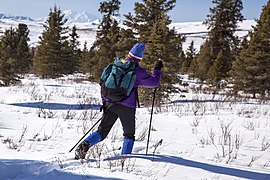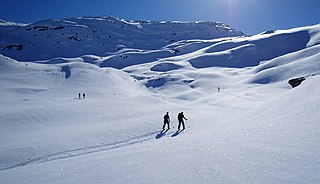
Cross-country skiing is a form of skiing whereby skiers traverse snow-covered terrain without use of ski lifts or other assistance. Cross-country skiing is widely practiced as a sport and recreational activity; however, some still use it as a means of transportation. Variants of cross-country skiing are adapted to a range of terrain which spans unimproved, sometimes mountainous terrain to groomed courses that are specifically designed for the sport.

Slalom is an alpine skiing and alpine snowboarding discipline, involving skiing between poles or gates. These are spaced more closely than those in giant slalom, super giant slalom and downhill, necessitating quicker and shorter turns. Internationally, the sport is contested at the FIS Alpine World Ski Championships, and at the Olympic Winter Games.

Skiing is the use of skis to glide on snow. Variations of purpose include basic transport, a recreational activity, or a competitive winter sport. Many types of competitive skiing events are recognized by the International Olympic Committee (IOC), and the International Ski and Snowboard Federation (FIS).

Winter sports or winter activities are competitive sports or non-competitive recreational activities which are played on snow or ice. Most are variations of skiing, ice skating and sledding. Traditionally, such games were only played in cold areas during winter, but artificial snow and artificial ice allow more flexibility. Playing areas and fields consist of either snow or ice.

Alpine skiing, or downhill skiing, is the pastime of sliding down snow-covered slopes on skis with fixed-heel bindings, unlike other types of skiing, which use skis with free-heel bindings. Whether for recreation or for sport, it is typically practiced at ski resorts, which provide such services as ski lifts, artificial snow making, snow grooming, restaurants, and ski patrol.

Telemark skiing is a skiing technique that combines elements of Alpine and Nordic skiing, using the rear foot to keep balance while pushing on the front foot to create a carving turn on downhill skis with toe-only bindings. Telemark skiing is named after the Telemark region of Norway, where the discipline originated. Sondre Norheim is often credited for first demonstrating the turn in ski races, which included cross country, slalom, and jumping, in Norway around 1868. Sondre Norheim also experimented with ski and binding design, introducing side cuts to skis and heel bindings.

Ski touring is skiing in the backcountry on unmarked or unpatrolled areas. Touring is typically done off-piste and outside of ski resorts, and may extend over a period of more than one day. It is similar to backcountry skiing but excludes the use of a ski lift or transport.
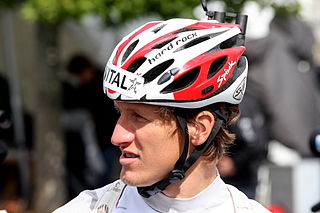
Lars Berger is a former Norwegian biathlete and cross-country skier.

The U.S. Ski Team, operating under the auspices of U.S. Ski & Snowboard, develops and supports men's and women's athletes in the sports of alpine skiing, freestyle skiing, cross-country, ski jumping, and Nordic combined. Since 1974 the team and association have been headquartered in Park City, Utah.
The Holmenkollen Ski Festival is a traditional annual Nordic skiing event in Holmenkollen, Oslo, Norway. The full official name of the event is Holmenkollen FIS World Cup Nordic.
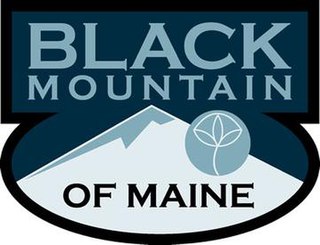
Black Mountain of Maine is a ski resort in Rumford, Maine which is most famous for its Nordic skiing facilities, and has hosted several national cross-country skiing championships on its 17 km of trails.
Peter Graves is an American television sportscaster and public address announcer specializing in Olympic, lifestyle, and action sports. He is also a former cross-country skiing coach for Harvard University.
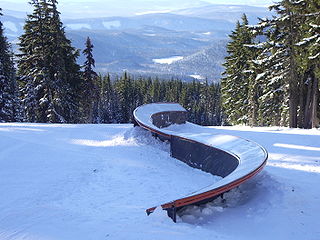
The following outline is provided as an overview of and topical guide to skiing:

The Whistler Olympic Park is the location of the Nordic events facilities for the 2010 Winter Olympics and is located in the Madeley Creek basin in the Callaghan Valley, west of Whistler, British Columbia, Canada. The facility hosted the biathlon, cross-country skiing, Nordic combined, and ski jumping. After the Olympics the park remains a public facility, complementing the extensive wilderness trails and alpine routes already in use. Three temporary stadiums were built with a capacity for 12,000 spectators each. The location is approximately 8 km from the junction of its access road with Highway 99 and 14 km from the Whistler Olympic Village.
For the 1960 Winter Olympics in Squaw Valley, California, in the United States, a total of five sports venues were used. Except for the Palisades Tahoe, all of the venues had to be constructed. For the first time in Winter Olympic history, a temporary venue was constructed at McKinney Creek for biathlon, cross-country skiing, and Nordic combined. A bobsleigh track was not constructed over the guarantees from the FIBT not being able to field the minimum twelve teams needed to compete, making it the only time bobsleigh has not been included in the Winter Olympics.

For the 1980 Winter Olympics in Lake Placid, New York, United States, a total of seven sports venues were used. All five of the venues used for the 1932 Winter Olympics were also used at the 1980 Winter Games with adjustments. These adjustments included electronic scoreboards, increased refrigeration, and the addition of a separate luge track. This was the last Winter Olympics where there were separate bobsleigh and luge tracks. The closest finish in Olympic history in cross-country skiing led skiing officials to time future events in hundredths of a second rather than tenths of a second. This would also apply to biathlon events. Eric Heiden won five gold medals at the speed skating oval while the "Miracle on Ice" took place between Americans and Soviets at the Olympic Center. In the late 1990s, the luge track was demolished and a new combination track was constructed in time for the only Winter Goodwill Games held. The sliding venue was named to the American National Register of Historical Places in February 2010.
LW3 is a para-alpine and para-Nordic standing skiing sport class defined by the International Paralympic Committee (IPC) for skiers with a disability affecting both legs, with double below knee amputation or a combined strength total for both legs of 60, with 80 as the baseline for people without disabilities. For international skiing competitions, classification is done through IPC Alpine Skiing or IPC Nordic Skiing. The classification has two subclasses for para-alpine skiing: LW3.1 which is for people with double below the knee amputations or similar disabilities, and LW3.2 which is for people with cerebral palsy that involves moderate athetoid, moderate ataxic impairment or slight diplegic involvement.

Competitive cross-country skiing encompasses a variety of race formats and course lengths. Rules of cross-country skiing are sanctioned by the International Ski Federation and by various national organizations. International competitions include the FIS Nordic World Ski Championships, the FIS Cross-Country World Cup, and at the Winter Olympic Games. Such races occur over homologated, groomed courses designed to support classic (in-track) and freestyle events, where the skiers may employ skate skiing. It also encompasses cross-country ski marathon events, sanctioned by the Worldloppet Ski Federation, and cross-country ski orienteering events, sanctioned by the International Orienteering Federation. Related forms of competition are biathlon, where competitors race on cross-country skis and stop to shoot at targets with rifles, and paralympic cross-country skiing that allows athletes with disabilities to compete at cross-country skiing with adaptive equipment.
Joseph Peter "Joe Pete" Wilson was an American Olympic cross-country skier, who skied for the U.S. in cross-country at the 1960 Winter Olympics and later became a well-known skiing administrator in the United States. Wilson also in collaboration authored several books on cross-country skiing, all co-written by William J. Lederer. Wilson set up the cross-country ski area at the Trapp Family Lodge in Stowe, Vermont – the lodge established by the Trapp family of The Sound of Music fame. In 1973, Wilson organized a meeting of 25 ski areas and established the National Ski Touring Operators' Association. Wilson was named as its first President from 1973-1977. After several name changes it is now called the Cross Country Ski Areas Association (CCSAA). CCSAA is an international association of U.S. and Canadian cross-country ski areas. Wilson is also known for having set up an inn in Keene, New York, the Bark Eater Inn, and developing the ski trails around the inn.
The Swiss Ski, is the winter sports federation for Switzerland. Part of the International Ski and Snowboard Federation (FIS), it deals with some federations conducting sports for the Winter Olympics, including skiing, biathlon and ski jumping.

